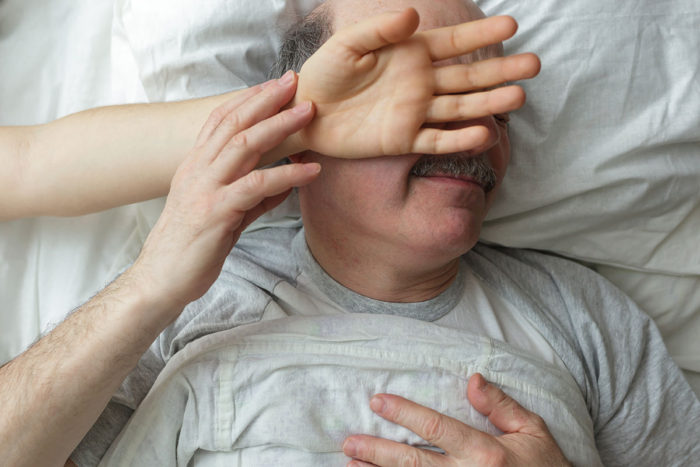People who act out dreams needed for study
Phenomenon linked to Parkinson’s, dementia, other serious neurodegenerative diseases
 Getty Images
Getty ImagesActing out dreams can be an early sign of serious neurological disease. A new study aims to identify which people with the disorder will go on to develop neurodegenerative diseases such as Parkinson’s, and to lay the groundwork to test treatments aimed at preventing such diseases.
Picture this: A soccer referee, dreaming he’s on the pitch, flings his arm up with an imaginary red card and accidentally smacks his sleeping partner in the face. Funny? Maybe on TV. In real life, acting out dreams is not only bad for domestic harmony, it can be a warning sign of looming neurodegenerative disease.
A new study led by researchers at Washington University School of Medicine in St. Louis and the Mayo Clinic aims to understand a rare condition called REM sleep behavior disorder (RBD) that leads people to act out their dreams. The goal is to identify which people with the disorder will go on to develop neurodegenerative diseases such as Parkinson’s, and to lay the groundwork to test treatments aimed at preventing such diseases.
“When I evaluate patients with this disorder, I don’t know if they’re going to progress to a neurodegenerative disease or when it might happen or which specific condition they may develop,” said Yo-El Ju, MD, an assistant professor of neurology at the School of Medicine. “Investigational drugs in the pipeline will be ready for testing in two or three years, but before we can do a clinical trial, we need to figure out who may be most likely to benefit.”
REM sleep behavior disorder is a rare diagnosis that affects fewer than five people out of 1,000 in the United States. Cases that are associated with use of antidepressant medication, brain injuries or the sleep disorder narcolepsy are unlikely to develop into other serious neurological diseases. But of people diagnosed with REM sleep behavior disorder with no clear cause, more than half go on to develop Parkinson’s disease, Lewy body dementia or multiple systems atrophy – which is characterized by Parkinson’s-like symptoms, plus problems with balance, blood pressure regulation, and bladder control – within 10 years.
The sleep movements can be treated with melatonin or other medications. But while such treatment may make it easier to share a bed with someone with the disorder, it does nothing to forestall neurological decline.
The link between acting out dreams and neurodegeneration comes down to a brain protein known as alpha-synuclein that can form toxic clumps. Such clumps often first coalesce in a part of the brain that paralyzes the body during REM (or dreaming) sleep. As that area becomes damaged, people start thrashing around as they dream. Over time, synuclein clusters continue to accumulate and injure ever larger areas of the brain, causing neurodegenerative diseases.
Toxic clusters of synuclein are a key feature of Parkinson’s disease, although not everyone with Parkinson’s first experiences REM sleep behavior disorder. A few experimental therapeutics designed to destroy synuclein clumps already look promising in clinical trials for Parkinson’s disease. Ju thinks such therapeutics also may help people with the disorder avoid developing Parkinson’s, Lewy body dementia or multiple systems atrophy in the first place.
“If any of those treatments do well and help people with Parkinson’s, we’ll want to evaluate them in RBD,” Ju said. “If they fail, maybe it’s because the treatment came too late in the disease process, so we’ll try them in RBD. Either way, we should have something to test in a few years.”
With Bradley F. Boeve, MD, of the Mayo Clinic, Ju is a co-principal investigator of the North American Prodromal Synucleinopathy (NAPS) Consortium, a research network formed in preparation for an RBD clinical trial. The first hurdle the consortium faces is the small number of patients and their lack of diversity. Most RBD patients are white men over age 50, but the condition is under-recognized, the researchers say. Men of other backgrounds and women also may have the disorder and not know it.
“There are only a handful of people being treated at academic sleep medicine centers for RBD who are not white or Asian,” Ju said. “I’m virtually certain people with other racial or ethnic backgrounds also get RBD. The racial disparities in diagnosis may stem from a lack of access to sleep specialists, differing cultural beliefs about when to seek care, or other reasons. For scientific reasons, it is important that we recruit a representative cohort of people with RBD. I think many people do not realize that acting out your dreams is a diagnosable, treatable condition that they should see a doctor about.”
The NAPS Consortium is recruiting people with sleep movements at seven sites in North America. Participants do not need to already be diagnosed with the disorder; the researchers will help steer potential participants to appropriate sleep centers. Those who qualify for the trial will undergo a two-hour battery of neurological tests to measure motor and cognitive function, as well as clinical tests to measure blood pressure, color vision and smell, among other things.
Each participant also will give a blood sample and, if willing, undergo a spinal tap so researchers can test spinal fluid for synuclein clumps. At a few sites, participants also will undergo brain scans. After the initial enrollment, researchers will follow the participants for two years. The goals of the study are to organize a group of people ready to enroll in a clinical trial when potential therapeutics become available, and to develop tests that can reliably predict who will go on to develop a neurodegenerative disease, and which disease each person will get.
For more information, visit the NAPS website at www.naps-rbd.org, call 314-747-6124 or email info@naps-rbd.org.






